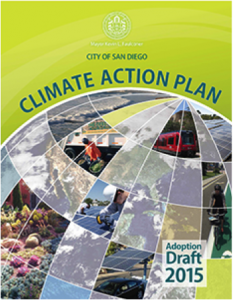Justin Gundlach
Climate Law Fellow
The City of San Diego has issued a climate action plan (CAP) that makes the City susceptible to law suits for noncompliance with its commitment to reduce greenhouse gas (GHG) emissions. That commitment is ambitious: by 2035, San Diego must cut emissions (measured against a 2010 baseline) in half and switch its energy infrastructure to 100% renewables.
To achieve these basic goals, the CAP puts forward a sweeping vision of changes to the transportation and energy sectors, as well as to the energy efficiency of buildings. But the CAP has made headlines chiefly because it is not only ambitious but also enforceable against the City. The nature of its enforceability, described below the jump, relies on California’s state-level commitments to GHG emissions reduction and on the role of the California Environmental Quality Act (CEQA) in guiding how state agencies and localities incorporate those commitments into the activities.
The CAP’s enforcement mechanism owes to its relationship to San Diego’s General Plan. That relationship is mediated by CEQA, which requires environmental review of state and municipal agency actions with significant environmental impacts—like the issuance by a City of a General Plan. The CAP makes express reference to San Diego’s General Plan at pages 14 to 16, as does the Final Program Environmental Impact Report (PEIR) at 2-2 and 2-3. The PEIR—a document required by CEQA—explains how the CAP aligns with the General Plan:
The CAP identifies strategies and actions to reduce the City’s carbon footprint, consistent with General Plan Policy CE-A.2:
Policy CE-A.2 to “reduce the City’s carbon footprint” and to “develop and adopt new or amended regulations, programs and incentives as appropriate to implement the goals and policies set forth” related to climate change.
Consistent with General Plan Policy CE-A.13, the CAP updates and expands upon the first Climate Protection Action Plan (CPAP), which was approved in 2005:
Policy CE-A.13 to “regularly monitor, update, and implement the City’s Climate Protection Action Plan, to ensure, at a minimum, compliance with all applicable federal, state, and local laws. ” * * *
The objectives of the CAP are to:
– Provide a roadmap to achieve [greenhouse gas (GHG)] reductions; . . .
– Implement climate action policies of the General Plan.
This might seem to be a subtle means of making the CAP enforceable, but that subtlety disappears when it is set against the backdrop of a recent case brought by the Sierra Club against San Diego County. That case demonstrated how CEQA can provide plaintiffs with a cause of action against a local government that does not abide by the GHG mitigation commitments called for by its General Plan. See Sierra Club v. County of San Diego, Case No. 37-2012-00101054-CU-TT-CTL, at 6 (Cal. Ct. App. 4th Dist. Oct. 29, 2014), rev. denied (Cal. Mar. 11, 2015). At issue in that case was the County’s 2011 General Plan Update, the PEIR for which included Mitigation Measure CC-1.2. That Mitigation Measure committed the County to preparing a Climate Action Plan that “will achieve comprehensive and enforceable GHG emissions reduction of 17% … from County operations from 2006 by 2020 and 9% reduction … in community emissions from 2006 by 2020.” Id. Because the County then adopted a CAP that fell well short of this commitment, the court determined that the CAP was inconsistent with the General Plan and consequently in violation of CEQA. See id. at 17 (“Once incorporated, mitigation measures cannot be defeated by ignoring them or by ‘attempting to render them meaningless by moving ahead with the project in spite of them.’”), at 26 (citing Pub. Resources Code, § 21081.6(b): “A public agency shall provide that measures to mitigate or avoid significant effects on the environment are fully enforceable …. in the case of the adoption of a plan, … by incorporating the mitigation measures into the plan….”).
Thus, with its new CAP, the City of San Diego has marched into a circumstance similar to the one that the County stumbled into in 2011: after adopting a General Plan consistent with California’s climate change mitigation goals, it adopted a CAP that specifies the particular commitments by which it will carry out its General Plan. Because adoption of the CAP was done in accordance with CEQA and entailed issuance of a PEIR, a cause of action is available against the City—as it was against the County—should the City depart from the commitments articulated in that PEIR.


